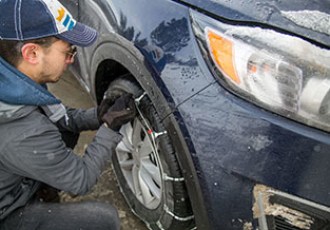BestReviews is reader-supported and may earn an affiliate commission. Details
We recommend these products based on an intensive research process that's designed to cut through the noise and find the top products in this space. Guided by experts, we spend hours looking into the factors that matter, to bring you these selections.

When it comes to choosing an RV tire, many people go with whatever is on their camper at the time, simply swapping like for like. Or, they opt for whatever is on sale at the local dealer. However, doing a bit of research before you buy can result in greater mileage, improved handling, and a more comfortable ride.
We looked at a huge range of RV tire models and evaluated their construction and use. Our recommendations underline a variety of price and performance options and offer something that will satisfy the majority of RV owners. The following guide delves into the details, provides practical tips, and answers a number of common questions about RV tires.

Tire size is a key element, and we explore that in detail in our FAQ section. The other big issue is the type of RV tire you need. There are two categories: ST (special trailer) and LT (light truck) tires.
ST-rated tires are often a good value, but it’s important to understand their intended use. As the name suggests, these are trailer tires. They are fine for towable RVs, fifth-wheel rigs, and pop-up campers or tent trailers, but they can’t be used on motorhomes and camper vans. The tires simply don’t have the structural strength for either steering or drive wheels. For those purposes, you need LT-rated tires, which are stronger and more supportive than ST-rated tires.
Buyers should note that P-rated tires (for passenger vehicles) must also be avoided. That’s the type of tire you’d fit to your car.

Radial tires are more popular because their construction provides better cooling, which increases mileage, and greater flexibility, which results in a more comfortable ride. LT-rated tires are almost invariably radial, and they may be reinforced with extra belts (plys) to handle the bigger loads of a large RV. Bias ply tires tend to be stiffer, which is fine for ST-rated trailer tires because ride comfort isn’t an issue. They usually cost less, too. However, your array of choices may not be as extensive.
The majority of RV tires possess a general-purpose design that handles wet roads well. Main grooves run around the tire, dissipating water. Tread blocks are kept reasonably small so the tire isn’t noisy.
However, if you’re likely to use your RV in more challenging conditions, it’s worth considering a set of snow tires. These are widely available for larger RVs because the same tires are used on commercial trucks. The alternative, though not as good as full-on snow tires, is all-season or all-terrain tires. This may be your only option on smaller RVs and trailers because snow tires may not be available. If you are towing, a practical solution is to fit snow tires to the tow vehicle itself. Snow chains are another consideration (and a legal requirement in some places).

There are some brands of RV tire you’ll recognize instantly. Often, you’ll pay a premium for these big names. Inexpensive ST-rated RV tires can cost as little as $75, and entry-level LT-rated tires can cost around $110, but you could pay up to $300 for them.
The question is, are big name tires superior to budget models? As long as they have the initials “DOT” marked on the sidewall, any RV tire is legal for road use in the states, so safety is not an issue. However, it may be argued that when you invest in tires from a big name, you’re paying for better technology. Tires with enhanced durability are more likely to offer a quiet, smooth ride and last longer. Whether the higher price tag is worth it is up to you.

Q. What do the numbers on my RV tires mean?
A. These numbers give you lots of important information, so let’s look at a typical set:
LT 215/65 R 16 110 H
Finally, there’s the date of manufacture, which starts with the letters DOT and is followed by 12 letters and numbers. Something like this:
DOT X6 AB 00 0D 2419
The only thing you’re concerned about is the last four numbers. The first two give the week of manufacture (in this case, 24), and the other two are the year (in this case, 2019).
You can choose whichever brand of tire you like, but never mess with size or weight ratings.
Q. What’s the minimum legal tread depth on RV tires?
A. Legally it’s 2/32 inch (we don’t know why it isn’t given as 1/16 inch). Several road safety organizations would like it raised to double that, but it hasn’t happened yet. Many tires have a wear indicator molded into the tread, so you can do a quick visual check rather than getting a gauge out all the time.
However, if the tires are over seven years old or you don’t know their age because you bought a used RV, it’s recommended you change them anyway.
Q. Should I rotate the tires on my RV?
A. It’s a good idea that’s recommended by the Rubber Manufacturers Association. They suggest rotating them every 6,000 to 8,000 miles. Combine that with proper care and regular pressure checks, and you might get as much as 50% additional mileage.
Get emails you’ll love.
Learn about the products you’re wondering if you should buy and get advice on using your latest purchases.
